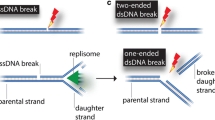Abstract
DNA metabolism was analyzed in spermatocytes of mice that were sterile either because of X-autosome or autosome-autosome translocations, or because of trisomy. In the strains analyzed, spermatogenic development is arrested by metaphase I or soon thereafter. In all such strains, a disruption of the normal pattern of pachytene DNA metabolism occurred. Prepachytene metabolism appeared normal. Disruption was manifest in both the level of endogenously generated nicks during pachytene and in the distribution of nicks among the different DNA sequence classes. Nicking was more intense in the steriles and tended to be randomized in distribution. Satellite DNA underwent pachytene nick-repair in the steriles but not in fertile controls. The repair capacity of spermatocytes from steriles was equal to that of the fertiles; the higher frequency of nicks in the steriles was due to a persistence of nicking activity.
Similar content being viewed by others
References
Boer, P. de: Fertile tertiary trisomy in the mouse. Cytogenet. Cell Genet. 12, 435–442 (1973)
Cacheiro, N.L.A., Russell, L.B., Swartout, M.S.: Translocations, the predominant cause of total sterility in sons of mice treated with mutagens. Genetics 76, 73–91 (1974)
Chandley, A.C., Hotta, Y., Stern, H.: Biochemical analysis of meiosis in the male mouse. I. Separation and DNA labeling of specific spermatogenic stages. Chromosoma (Berl.) 62, 243–253 (1977)
Eicher, E.M.: X-autosome translocations in the mouse: total inactivation versus partial inactivation of the X chromosome. Advanc. Genet. 15 175–259 (1970)
Forejt, J., Gregorová, S.: Meiotic studies of translocations causing male sterility in the mouse. I. Autosomal reciprocal translocations. Cytogenet. Cell Genet. 19, 159–179 (1977)
Hotta, Y., Bennett, M.D., Toledo, L.A., Stern, H.: Regulation of R-protein and endonuclease activities in meiocytes by homologous chromosome pairing. Chromosoma (Berl.) 72, 191–201 (1979)
Hotta, Y., Chandley, A.C., Stern, H.: Biochemical analysis of meiosis in the male mouse. II. DNA metabolism in pachytene. Chromosoma (Berl.) 62, 255–268 (1977)
Hotta, Y., Stern, H.: Absence of satellite DNA synthesis during meiotic prophase in mouse and human spermatocytes. Chromosoma (Berl.) 69, 323–330 (1978)
Kofman-Alfaro, S., Chandley, A.C.: Radiation-initiated DNA synthesis in spermatogenic cells of the mouse. Exp. Cell Res. 69, 33–44 (1971)
Lieberman, M.W.: Fractionation of mouse DNA in preparative Ag+-Cs 2SO4 gradients. Biochim. biophys. Acta (Amst.) 324, 309–319 (1973)
Lifschytz, E., Lindsley, D.L.: The role of X-chromosome inactivation during spermatogenesis. Proc. nat. Acad. Sci. (Wash.) 69, 182–186 (1972)
Lyon, M.F., Meredith, R.: Autosomal translocations causing male sterility and viable aneuploidy in the mouse. Cytogenetics 5, 335–354 (1966)
Lyon, M.F., Searle, A.G., Ford, C.E., Ohno, S.: A mouse translocation suppressing sex-linked variegation. Cytogenetics 3, 306–323 (1964)
Moses, M.J., Russell, L.B., Cacheiro, N.L.A.: Mouse chromosome translocations: visualization and analysis by electron microscopy of the synaptonemal complex. Science 196, 892–894 (1977)
Russell, L.B.: A second T(X;8) in the mouse. Genetics 71, 553–554 (1972)
Russell, L.B.. Bangham, J.W.: Variegated-type position effects in the mouse. Genetics 46, 509–525 (1961)
Russell, L.B., Montgomery, C.S.: Comparative studies in X-autosome translocations in the mouse. I. Origin, viability, fertility, and weight of five T(X;1)'s. Genetics 63, 103–120 (1969)
Searle, A.G.: Symposium on mammalian radiation genetics: summary and synthesis. Mutation Res. 11, 133–147 (1971)
Searle, A.G.: Nature and consequence of induced chromosome damage in mammals. Genetics 78, 173–186 (1974)
Searle, A.G., Beechey, C.V., Evans, E.P.: Meiotic effects in chromosomally derived male sterility of mice. Ann. Biol. Anim. Bioch. Biophys. 18, 391–398 (1978)
Stich, H.F., San, R.H.C.: DNA repair and chromatid anomalies in mammalian cells exposed to 4-nitroquinoline 1-oxide. Mutation Res. 10, 389–404 (1970)
Studier, F.W.: Sedimentation studies of the size and shape of DNA. J. molec. Biol. 11, 373–380 (1965)
Author information
Authors and Affiliations
Rights and permissions
About this article
Cite this article
Hotta, Y., Chandley, A.C., Stern, H. et al. A disruption of pachytene DNA metabolism in male mice with chromosomally-derived sterility. Chromosoma 73, 287–300 (1979). https://doi.org/10.1007/BF00288693
Received:
Accepted:
Issue Date:
DOI: https://doi.org/10.1007/BF00288693




